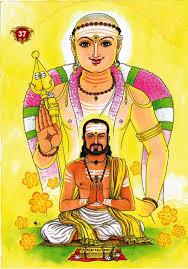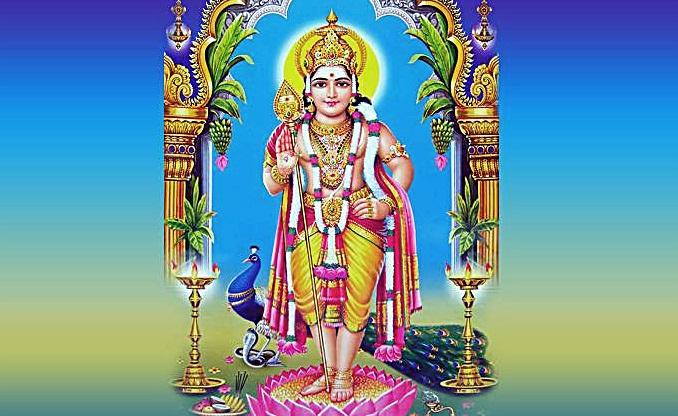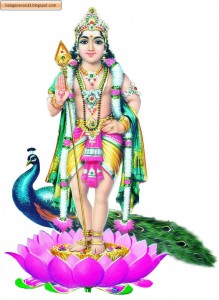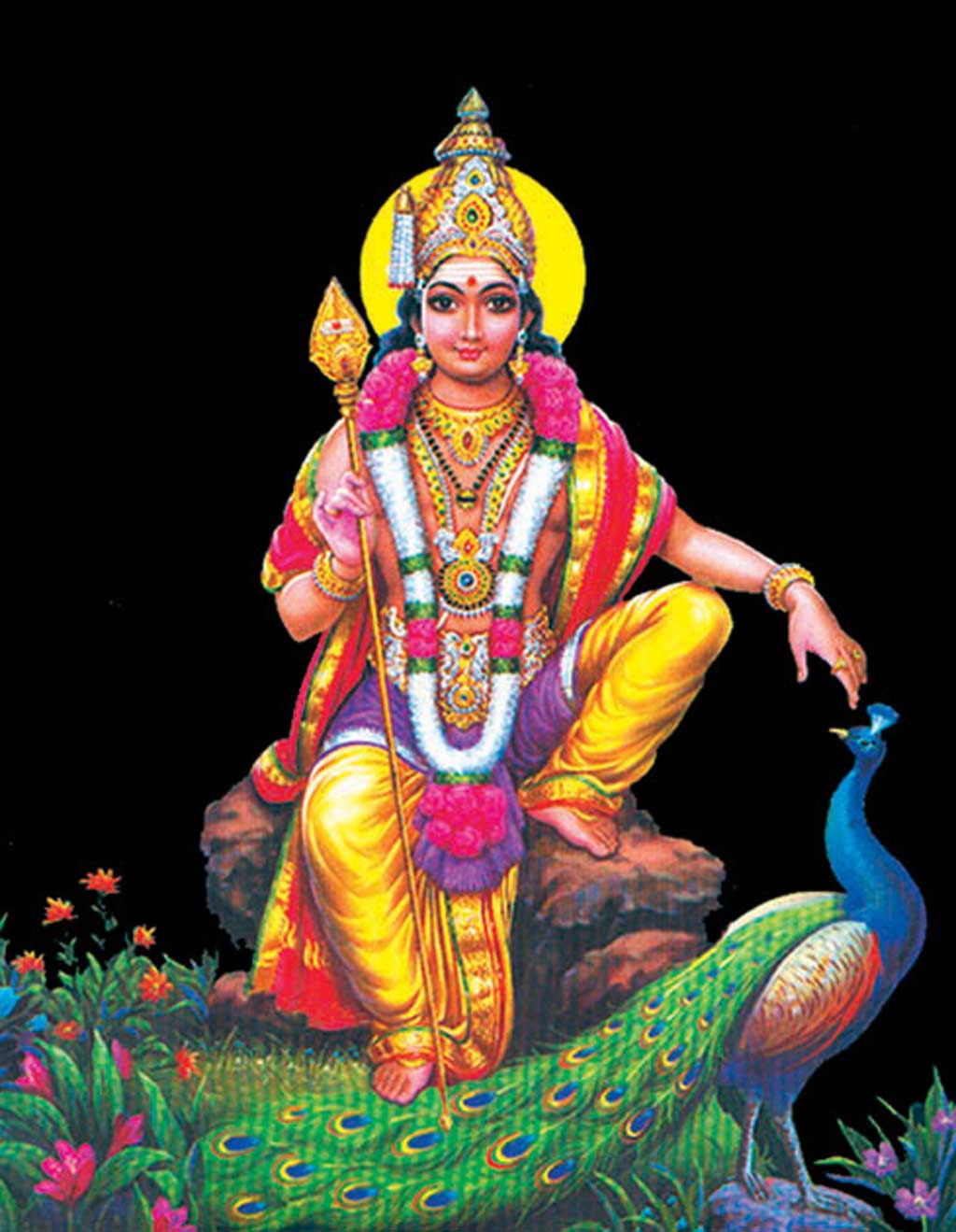
A saint went to Palani to worship Lord Dhandayuthapani. First, he decided to perform the Giri Pradakshinam; the act of going round the hill reciting the sacred names of the Lord. As he was walking around the hill, he was distressed to see certain sights. There were people suffering from acute diseases, there were poor people suffering from starvation and people deprived of a roof above to protect them from rain and shine. He then went near a Mutt, sat there and wondered why there is so much sufferings and agony right here, at the abode of Muruga. As it was late night, he lied down there and gradually went to sleep. During the sleep, he saw a dream in which Muruga appeared and said: “My blessing is there to all devotees. You have the power to compose a song that will free one and all from past karmas. Compose a song that will kindle the light of devotion in their heart; the song by which they will reach Me. Compose a song in a way that would serve as a Mantra and remove the sufferings of the people and lead them to a life of happiness and prosperity.” The awakened got awakened and the experience of having seen Muruga helped him to compose the song. The saint, whose compositions became the most outstanding prayer to Lord Muruga, was Sri Devaraya Swamigal and the song he composed in splendid verses spanning over 238 lines was Kandha Sashti Kavacham. If there is one song that is heard at all the residences of devotees, at temples and consorts constantly, it is Kandha Sashti Kavacham.
Sri Devaraya Swamigal was born at Valloor, situated in the region bordering Tamil Nadu and Andhra, known as Thondaimandalam. It is said that as a result of intense devotion of the parents, a child was born to them whom they named as Devarasan, the King of Devas. The father, Sri Veerasamy was doing the account maintenance work in an establishment and this avocation he passed on to his son, Devarasan. With the knowledge gained from his father, Devarasan went to Bangalore and established a flourishing business there. Devarasan set his goal higher; to know more, to serve and seek the grace of Lord Muruga. He heard that the great Pundit of Trisirapuram, Sri Meenakshi Sundaram Pillai belonging to Thiruvavadu Adheenam has come to Bangalore and he invited the scholar to his house. An ardent devotee of Muruga, the Lord described as Thamizh Kadavul (God of the Tamils), Sri Devarasan also became lover of Tamil, the language of infinite beauty. He knew that Sri Pillai’s duration of stay at Bangalore was very short. However, he decided to request the Pundit to accept him as his student and teach him Tamil literature. He composed a work called “Kuselobagyanam”, presented it to Sri Pillai and made a gentle request to Sri Pillai to fulfill his aspiration. A glance was enough and Sri Pillai was convinced that Sri Devarasan had the potential to become a scholar and agreed to sit with him. What the Guru does is not to impart knowledge because the knowledge is already there in the Sishya. Guru merely removes the veil of darkness that surrounds the disciple. Soon, Sri Devarayan emerged as an enlightened poet. Some of the works that Sri Devarasan has done are Thanikachala Malai and Panchagra Desikar Pathigam. He has composed songs on each Padai Veedu of Lord Muruga. ‘Satru Samhara Vel Pathikam’ and ‘Subramanya Virutham’ are the other notable songs he composed.
Muruga is known by many names and one of which is Subrahmanya, ‘Su’ signifying the sacredness and ‘Brahmanya’ signifying Brahman. He is the reflection of Brahman, the eternal reality. He originated from the flame of fire. He is with form and without form. He is without qualities (Nirguna). Though he is one, he appeared as many. He appeared in the form of Kandha in order to protect the Devas from the atrocities of demon Sooran. According to legend, as a result of the appeal made by Devas and their head, Indira, for protection, a powerful flame appeared from the third eye of Siva. Carried by Lord of Air, (Vayu) and Lord of Fire, (Agni), the flame was deposited in Ganga from where it reached Saravana Poigai in South. Since he came up among the sacred bush of reeds in the river Saravana Poigai, he came to be known as Saravanabhava. The flame was transformed into 6 beautiful babies. Since the wives of sages shining as stars came down, nursed and brought up the babies, he was known as Karthikeya. As Goddess Parvati came, embraced the babies and merged them into one, he came to be known as Skandha. The word ‘Skandha’ means being integrated. Skandha also means the integrated power of Vishnu, Mukunda (MU), Siva, Rudra (RU) and Sakthi or Kartyayini (KA). It is believed that Skanda is the combined form of Lord of Fire, (Agni), Indira, Varuna, Brahaspati and Hiranya Garbam. Skandha emerged as a beautiful child. When the young child came to his mother, Parvati took him in her lap and gave him the milk of knowledge (Jnana Pal). As the child grew up as a handsome youth, the mother gave him another gift; the Vel, as a reminder of the purpose for which he appeared on earth; to eliminate the evil forces, protect the devotees and establish Dharma, the path of truth. It was on the day of Sashti Thidi, the 6th day of the Shukla Paksha in the month of Karthika (October-November), Lord Skandha defeated the evil forces represented by Soorapadman and his brothers, Singhamugan and Tarakasuran and the day which marked the triumph of good over evil is celebrated as Kandha Sashti.
In fact, Kandha manifested not just to put an end to the atrocities of demons like Sooran. The Vel that he wields is not meant just to eliminate the evil forces of his time. Humanity continues to face challenges and threats like poverty, ignorance, diseases. It continues to face challenges from evil forces appearing from time to time. Therefore, Muruga is ever present, at our beck and call, to guide us, grace us and lead us to the path of Dharma. Sri Devaraya Swamigal has given us the beautiful prayer-song which invites Muruga to our door-step and shields us from our obstacles, external as well as internal.
The ‘Kandha Sashti Kavacham’ begins by welcoming Muruga who arrives mounted on his beautiful transport, the peacock to give us strength, courage and confidence to sail through this ocean of Samsara peacefully and happily. Muruga has manifested with form and without form. The magnificence of Lord Muruga is indescribable. While at Swami Malai, Muruga appears as a Jnani, at Palani as a renounced saint, at Tirupparamkundram and Thiruthani with his consorts, at Pazhamudir Solai as a matured old man and at Tiruchendur he appears as an embodiment of beauty. Kavacham describes the beauty of Muruga in eloquent verses. As we recite the lines that describe Him, we visualize Muruga in his splendour and glory, sing and meditate on Him. The Kavacham says: “Oh Muruga, the Lord who mounts on his beautiful transport, the peacock, the Lord who has his consort, Valli, the young girl noted for her devotion, the Lord whose name, Saravanabava, resonates music into our ears, the Lord who holds different weapons to protect us from various hazards, the Lord who appears magnificent in his different ornaments that produce melodious music, the Lord who wears the garland of Kadamba flowers, the Lord who appears as Swaminatha at Swami Malai, radiating knowledge, Oh! Kandha come and bless us to have a heart that always rests at your Lotus Feet.” An ardent Muruga devotee who recites Kavacham daily said: “Perhaps, in describing the beauty, compassion and the infinite power of Lord Muruga, His spear, the Vel, His transport, the peacock and His ensign, the rooster, Kandha Sashti Kavacham may be regarded as the close fourth after Thirumurugatru Padai, Kandha Puranam and Thiruppugazh.
Apart from being a song that hails the glory of Muruga, that describe the magnificence of Muruga and that gives expression of deep devotion towards Muruga, the songs serve as shield of protection to the devotees from all threats. There are various elements that distract me, hazards that obscures our vision, objects that obstruct our path, spirits that cause fear and above all the mind that creates a false notion of ‘I’ (ego). The ‘Kavacham’ prays: “Oh Muruga, come and protect me from all these dangers”.
The saint himself experienced the miraculous power of the song. Once, he was afflicted by a stomach ailment. The pain in the stomach was unbearable. He went straight to Senthil Andavar, whom Sri Arunagirinathar described as Bhavaroga Vaidyanatha, the Physician who came to cure the disease of repeated birth and death. The day happened to be Sashti. Sitting before the merciful Lord, Swamigal started rendering the song ‘Sashtiyai Nokka’ and soon the pain in the stomach disappeared, like the snows that disappear with the onset of the sun. Needless to say, if only one recites Kandha Sashti Kavacham with devotion and Shraddha (involvement), it is certain that he will be protected from threats from the eight directions (Ashta Dhikkiullor Adangalum..), from all evil spirits, from Karma effects and from all obstacles. In fact, he would be able to live beyond the need for a physician, beyond the world of illusion and beyond the distractions of mind ever in the state of supreme spiritual fulfillment.
Muruga devotees like Kumaraguruparar, the author of ‘Kandar Kali Venpa’, Pagazhi Kuthar, author of ‘Tiruchendur Pillai Thamizh’ and Saivite saints known as Nayanmars all highlighted the importance of Vibhuti, the sacred ash. The Vibhuti gives us the message that one day this body would perish. It would be consigned to flames and turned into ashes and the Atma would be merged with Muruga, the eternal reality. However, so long the life journey continues, the body has its utility. The body is like a boat which the passenger uses to reach his destination, the Lotus Feet of Muruga. Just as the boat-man attends to the repairs of the boat, the devotee who seeks union with God also maintains his body in a pure and perfect manner. Kandha Sashti Kavacham serves as armour or shield to safeguard and protect the body from various dangers it faces like ailments, inclinations, Vasanas, desires etc. The Kandha Sashti Kavacham invokes the power of Muruga’s spear; the Vel for protection from all these obstacles. First it says: “Protect my head that always bows at your Lotus Feet” (Un Thiruvadiyai uruthi yendrennum, yen thalai vaithun yinaiyadi kaakka). Then it says “Protect my fore-head that is smeared with vibhuti” (Podipunai Netriyai Punidhavel Kaakka). In his Subramanian Bhujangam, Adi Sankara says: “Various diseases that afflict humans like epilepsy and leprosy and evil spirits vanish the moment one applies the sacred ashes served on the leaf and applied on the forehead”. The Kavacham continues: “Let the Vel that radiates the powerful rays protection my eyes” (Kadhirvel Irandum Kanninai Kaakka). We are blessed with two eyes by which we are able to see different objects. But we are also provided with an inner eye by which we get the real vision. While the outer eyes see the passing images outside, the inner eyes give us the vision, the Viveka by which we are able to discriminate between truth and the untruth, the real and the unreal. The ‘Kavacham’ seeks protection and guidance to the eyes to see only the good, the real and the sacred.
The two ears have unique importance. In his song done at Palani, Arunagirinathar says: “Oh! Muruga, as you conveyed the Upadesa Mantra into the two ears of Siva, come as Guru and give the same Upadesa into my ears as well.” (Sivanar Manam Kulira) According to Srimad Bhagavatam, listening is the ideal and effortless way for Realization. It says just by hearing, Lord Hari would take a permanent seat in the heart of the listener. (Yasyasravanamatrena Hari chithamsamasrayeth. ). Hiranyhakasipu, the demon King arranged a teaching session for his son, Prahlada, to perpetuate his own name and fame. When Prahlada returned and was asked what he had learned from his teachers, he said: “To hear the names and glories of Lord Vishnu, chant them, to remember Hari and His names. This is the highest form of devotion and this is the lesson I learned”. (Sravanam Keerthanam Vishno, Smaranam Pada Sevanam) Thus, ears perform an important function that even leads us to God Realization. Even if a Mantra or a devotional song is not understood, when heard through the ears, they would definitely make a positive impact into the person. There is no doubt that what is heard through the eyes would reach the heart and bloom later. The Kavacham therefore seeks protection to the ears (Vithisevi Irandum Velavar Kaaka). The song goes on seeking protection to all parts of human body and especially the Lotus heart where the Atma shines (Naabi Kamalam Nalvel Kakka) and it seeks protection right up to the feet. (Kanaikaal Muzhanthaal Kadhirvel Kakka). The powerful, sparkling and pointed Vel of Muruga not only protects but also guides the devotees and enlightens them. Above all, the song seeks the grace of Muruga; the divine grace that gives a spiritual protection to the devotee.

It is said that while standing before the Lord of Tiriuchendur, Devaraya Swamigal was moved beyond words and his heart melted in devotion and the inspiration for composing Kavacham came. In his song done at Tiruchendur, Arunagirinathar says: “Oh Muruga, how beautiful you look with different ornaments like Thandai Ani, Vendai, Kingini and Chadangai. I wish to marvel at your beauty. Would you not come before me, your head adorned by dazzling crown, your shoulder adorned by garland of Kadampa flowers and your hands reddish like lotus flour? (Thandayani Vendayum Kingini Sadangayum).
Palani is one of the six abodes of Lord Muruga. Palani wears a festive look every day but when Thaipusam comes, the festivities, the worship and bhajans which take place around Palani defy description. A steady stream of devotees starts flowing towards Palani with the sacred mantra: “Hara Haro Hara Hara”. They converge at Palani Hill, recite the names of Muruga, wait for hours together with the eagerness to have a glimpse of the Lord and get His grace. The whole atmosphere is charged with the air of divinity. For them, no other thought occupies the mind except that of Muruga. According to common belief, it was on the day of Thaipusam, (month, ‘Thai’ and star Pusam) mother Parvathi gave the Vel to the young Kumara. The Tamil word, ‘Vel’, was derived from the word ‘Velluthal’ which means victory. Therefore, Thaipusam is celebrated as a mark of victory of good over evil. According to Arunagirinathar, the Vel of Muruga would ward off the adverse effects arising out of Karma (‘Vinai Theerkkum Kadir Vel’). The ‘Kavadi’ offering is unique in Palani. “Kavadi’ is an arch-like wooden pole decorated with flowers with a small pot of milk attached to both ends of the pole. The Kavadi which is carried over the shoulder is synonymous with burdens that one carries in his material life. When the Kavadi is off-loaded before Lord Dhandayudhapani, it means surrender. Even when partial surrender takes place, all the burdens, karma effects and problems disappear. Skandha Sashti Kavacham says: “Oh! The young Lord who reigns supreme at the abode of Palani, Oh Lord, who looks beautiful with His Vel at Thiru Avinangudi, protect me” (Pazhani Pathivaazh Bala Kumara, Avinankudi vaazh Azhagiya Vela).
The Kandha Sashti Kavacham which seeks the grace of Muruga ends by saying: Oh Muruga, I surrender unto the Lotus Feet of Shanmuga. Come and take me unto you as your son” He who discards all desires, who distances himself from the world of illusion, who dedicates himself to the worship of Lord Muruga and surrender unto the Lotus Feet of the Lord liberates himself from the ocean of Samsara. Kandha Sashti Kavacham is rendered by many devotees and particular mention should be made about Sulamangalam Sisters who have rendered it in a voice choked with devotion.

